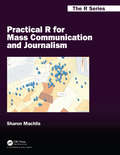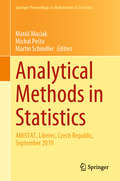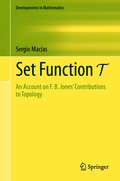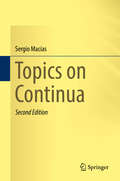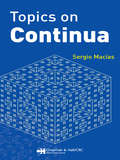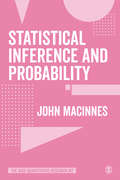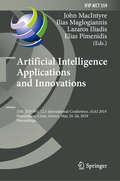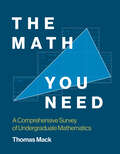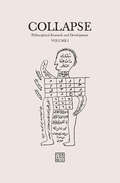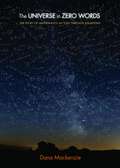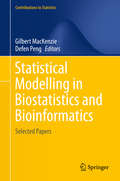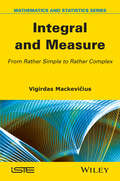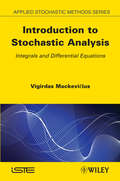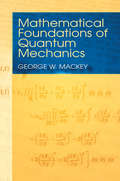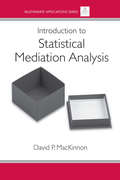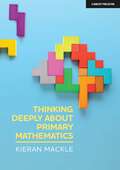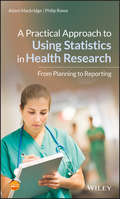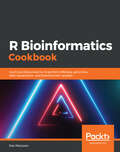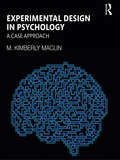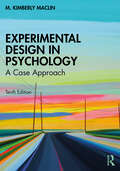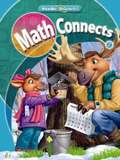- Table View
- List View
Practical R for Mass Communication and Journalism (Chapman & Hall/CRC The R Series)
by Sharon MachlisDo you want to use R to tell stories? This book was written for you—whether you already know some R or have never coded before. <P>Most R texts focus only on programming or statistical theory. Practical R for Mass Communication and Journalism gives you ideas, tools, and techniques for incorporating data and visualizations into your narratives. <P>You’ll see step by step how to: <li>Analyze airport flight delays, restaurant inspections, and election results <li>Map bank locations, median incomes, and new voting districts <li>Compare campaign contributions to final election results <li>Extract data from PDFs <li>Whip messy data into shape for analysis <li>Scrape data from a website <li>Create graphics ranging from simple, static charts to interactive visualizations for the Web <P>If you work or plan to work in a newsroom, government office, non-profit policy organization, or PR office, Practical R for Mass Communication and Journalism will help you use R in your world. <P>This book has a companion website with code, links to additional resources, and searchable tables by function and task. <P>Sharon Machlis is the author of Computerworld’s Beginner’s Guide to R, host of InfoWorld’s Do More With R video screencast series, admin for the R for Journalists Google Group, and is well known among Twitter users who follow the #rstats hashtag. She is Director of Editorial Data and Analytics at IDG Communications (parent company of Computerworld, InfoWorld, PC World and Macworld, among others) and a frequent speaker at data journalism and R conferences.
Analytical Methods in Statistics: AMISTAT, Liberec, Czech Republic, September 2019 (Springer Proceedings in Mathematics & Statistics #329)
by Matúš Maciak Michal Pešta Martin SchindlerThis book collects peer-reviewed contributions on modern statistical methods and topics, stemming from the third workshop on Analytical Methods in Statistics, AMISTAT 2019, held in Liberec, Czech Republic, on September 16-19, 2019. Real-life problems demand statistical solutions, which in turn require new and profound mathematical methods. As such, the book is not only a collection of solved problems but also a source of new methods and their practical extensions. The authoritative contributions focus on analytical methods in statistics, asymptotics, estimation and Fisher information, robustness, stochastic models and inequalities, and other related fields; further, they address e.g. average autoregression quantiles, neural networks, weighted empirical minimum distance estimators, implied volatility surface estimation, the Grenander estimator, non-Gaussian component analysis, meta learning, and high-dimensional errors-in-variables models.
Set Function T: An Account on F. B. Jones' Contributions to Topology (Developments in Mathematics #67)
by Sergio MacíasThis book presents, in a clear and structured way, the set function \mathcal{T} and how it evolved since its inception by Professor F. Burton Jones in the 1940s. It starts with a very solid introductory chapter, with all the prerequisite material for navigating through the rest of the book. It then gradually advances towards the main properties, Decomposition theorems, \mathcal{T}-closed sets, continuity and images, to modern applications.The set function \mathcal{T} has been used by many mathematicians as a tool to prove results about the semigroup structure of the continua, and about the existence of a metric continuum that cannot be mapped onto its cone or to characterize spheres. Nowadays, it has been used by topologists worldwide to investigate open problems in continuum theory.This book can be of interest to both advanced undergraduate and graduate students, and to experienced researchers as well. Its well-defined structure make this book suitable not only for self-study but also as support material to seminars on the subject. Its many open problems can potentially encourage mathematicians to contribute with further advancements in the field.
Topics on Continua
by Sergio MacíasThis book is a significant companion text to the existing literature on continuum theory. It opens with background information of continuum theory, so often missing from the preceding publications, and then explores the following topics: inverse limits, the Jones set function T, homogenous continua, and n-fold hyperspaces. In this new edition of the book, the author builds on the aforementioned topics, including the unprecedented presentation of n-fold hyperspace suspensions and induced maps on n-fold hyperspaces. The first edition of the book has had a remarkable impact on the continuum theory community. After twelve years, this updated version will also prove to be an excellent resource within the field of topology.
Topics on Continua
by Sergio MaciasSpecialized as it might be, continuum theory is one of the most intriguing areas in mathematics. However, despite being popular journal fare, few books have thoroughly explored this interesting aspect of topology. In Topics on Continua, Sergio Macias, one of the field's leading scholars, presents four of his favorite continuum topics: inv
Statistical Inference and Probability (The SAGE Quantitative Research Kit)
by John MacInnesAn experienced author in the field of data analytics and statistics, John Macinnes has produced a straight-forward text that breaks down the complex topic of inferential statistics with accessible language and detailed examples. It covers a range of topics, including: · Probability and Sampling distributions · Inference and regression · Power, effect size and inverse probability Part of The SAGE Quantitative Research Kit, this book will give you the know-how and confidence needed to succeed on your quantitative research journey.
Statistical Inference and Probability (The SAGE Quantitative Research Kit)
by John MacInnesAn experienced author in the field of data analytics and statistics, John Macinnes has produced a straight-forward text that breaks down the complex topic of inferential statistics with accessible language and detailed examples. It covers a range of topics, including: · Probability and Sampling distributions · Inference and regression · Power, effect size and inverse probability Part of The SAGE Quantitative Research Kit, this book will give you the know-how and confidence needed to succeed on your quantitative research journey.
Artificial Intelligence Applications and Innovations: 15th IFIP WG 12.5 International Conference, AIAI 2019, Hersonissos, Crete, Greece, May 24–26, 2019, Proceedings (IFIP Advances in Information and Communication Technology #559)
by John MacIntyre Ilias Maglogiannis Lazaros Iliadis Elias PimenidisThis book constitutes the refereed proceedings of the 15th IFIP WG 12.5 International Conference on Artificial Intelligence Applications and Innovations, AIAI 2019, held in Hersonissos, Crete, Greece, in May 2019.The 49 full papers and 6 short papers presented were carefully reviewed and selected from 101 submissions. They cover a broad range of topics such as deep learning ANN; genetic algorithms - optimization; constraints modeling; ANN training algorithms; social media intelligent modeling; text mining/machine translation; fuzzy modeling; biomedical and bioinformatics algorithms and systems; feature selection; emotion recognition; hybrid Intelligent models; classification - pattern recognition; intelligent security modeling; complex stochastic games; unsupervised machine learning; ANN in industry; intelligent clustering; convolutional and recurrent ANN; recommender systems; intelligent telecommunications modeling; and intelligent hybrid systems using Internet of Things. The papers are organized in the following topical sections:AI anomaly detection - active learning; autonomous vehicles - aerial vehicles; biomedical AI; classification - clustering; constraint programming - brain inspired modeling; deep learning - convolutional ANN; fuzzy modeling; learning automata - logic based reasoning; machine learning - natural language; multi agent - IoT; nature inspired flight and robot; control - machine vision; and recommendation systems.
The Math You Need: A Comprehensive Survey of Undergraduate Mathematics
by Thomas MackA comprehensive survey of undergraduate mathematics, compressing four years of study into one robust overview.In The Math You Need, Thomas Mack provides a singular, comprehensive survey of undergraduate mathematics, compressing four years of math curricula into one volume. Without sacrificing rigor, this book provides a go-to resource for the essentials that any academic or professional needs. Each chapter is followed by numerous exercises to provide the reader an opportunity to practice what they learned. The Math You Need is distinguished in its use of the Bourbaki style—the gold standard for concision and an approach that mathematicians will find of particular interest. As ambitious as it is compact, this text embraces mathematical abstraction throughout, avoiding ad hoc computations in favor of general results.Covering nine areas—group theory, commutative algebra, linear algebra, topology, real analysis, complex analysis, number theory, probability, and statistics—this thorough and highly effective overview of the undergraduate curriculum will prove to be invaluable to students and instructors alike.
Collapse: Philosophical Research and Development (Urbanomic #Vol. 1)
by Robin MackayAn investigation of the nature and philosophical uses of number. The first volume of Collapse investigates the nature and philosophical uses of number. The volume includes an interview with Alain Badiou on the relation between philosophy, mathematics, and science, an in-depth interview with mathematician Matthew Watkins on the strange connections between physics and the distribution of prime numbers, and contributions that demonstrate the many ways in which number intersects with philosophical thought—from the mathematics of intensity to terrorism, from occultism to information theory, and graphical works of multiplicity.
The Universe in Zero Words
by Dana MackenzieMost popular books about science, and even about mathematics, tiptoe around equations as if they were something to be hidden from the reader's tender eyes. Dana Mackenzie starts from the opposite premise: He celebrates equations. No history of art would be complete without pictures. Why, then, should a history of mathematics--the universal language of science--keep the masterpieces of the subject hidden behind a veil?The Universe in Zero Words tells the history of twenty-four great and beautiful equations that have shaped mathematics, science, and society--from the elementary (1+1=2) to the sophisticated (the Black-Scholes formula for financial derivatives), and from the famous (E=mc2) to the arcane (Hamilton's quaternion equations). Mackenzie, who has been called "a popular-science ace" by Booklist magazine, lucidly explains what each equation means, who discovered it (and how), and how it has affected our lives.Illustrated in color throughout, the book tells the human and often-surprising stories behind the invention or discovery of the equations, from how a bad cigar changed the course of quantum mechanics to why whales (if they could communicate with us) would teach us a totally different concept of geometry. At the same time, the book shows why these equations have something timeless to say about the universe, and how they do it with an economy (zero words) that no other form of human expression can match.The Universe in Zero Words is the ultimate introduction and guide to equations that have changed the world.
Statistical Modelling in Biostatistics and Bioinformatics
by Gilbert Mackenzie Defen PengThis book presents selected papers on statistical model development related mainly to the fields of Biostatistics and Bioinformatics. The coverage of the material falls squarely into the following categories: (a) Survival analysis and multivariate survival analysis, (b) Time series and longitudinal data analysis, (c) Statistical model development and (d) Applied statistical modelling. Innovations in statistical modelling are presented throughout each of the four areas, with some intriguing new ideas on hierarchical generalized non-linear models and on frailty models with structural dispersion, just to mention two examples. The contributors include distinguished international statisticians such as Philip Hougaard, John Hinde, Il Do Ha, Roger Payne and Alessandra Durio, among others, as well as promising newcomers. Some of the contributions have come from researchers working in the BIO-SI research programme on Biostatistics and Bioinformatics, centred on the Universities of Limerick and Galway in Ireland and funded by the Science Foundation Ireland under its Mathematics Initiative.
Integral and Measure: From Rather Simple to Rather Complex
by Vigirdas MackeviciusThis book is devoted to integration, one of the two main operations in calculus. In Part 1, the definition of the integral of a one-variable function is different (not essentially, but rather methodically) from traditional definitions of Riemann or Lebesgue integrals. Such an approach allows us, on the one hand, to quickly develop the practical skills of integration as well as, on the other hand, in Part 2, to pass naturally to the more general Lebesgue integral. Based on the latter, in Part 2, the author develops a theory of integration for functions of several variables. In Part 3, within the same methodological scheme, the author presents the elements of theory of integration in an abstract space equipped with a measure; we cannot do without this in functional analysis, probability theory, etc. The majority of chapters are complemented with problems, mostly of the theoretical type. The book is mainly devoted to students of mathematics and related specialities. However, Part 1 can be successfully used by any student as a simple introduction to integration calculus.
Introduction to Stochastic Analysis: Integrals and Differential Equations
by Vigirdas MackeviciusThis is an introduction to stochastic integration and stochastic differential equations written in an understandable way for a wide audience, from students of mathematics to practitioners in biology, chemistry, physics, and finances. The presentation is based on the naïve stochastic integration, rather than on abstract theories of measure and stochastic processes. The proofs are rather simple for practitioners and, at the same time, rather rigorous for mathematicians. Detailed application examples in natural sciences and finance are presented. Much attention is paid to simulation diffusion processes. The topics covered include Brownian motion; motivation of stochastic models with Brownian motion; Itô and Stratonovich stochastic integrals, Itô’s formula; stochastic differential equations (SDEs); solutions of SDEs as Markov processes; application examples in physical sciences and finance; simulation of solutions of SDEs (strong and weak approximations). Exercises with hints and/or solutions are also provided.
Mathematical Foundations of Quantum Mechanics (Dover Books On Physics Series)
by George W. MackeyDesigned for students familiar with abstract mathematical concepts but possessing little knowledge of physics, this text focuses on generality and careful formulation rather than problem-solving. Its author, a member of the distinguished National Academy of Science, based this graduate-level text on the course he taught at Harvard University.Opening chapters on classical mechanics examine the laws of particle mechanics; generalized coordinates and differentiable manifolds; oscillations, waves, and Hilbert space; and statistical mechanics. A survey of quantum mechanics covers the old quantum theory; the quantum-mechanical substitute for phase space; quantum dynamics and the Schrödinger equation; the canonical "quantization" of a classical system; some elementary examples and original discoveries by Schrödinger and Heisenberg; generalized coordinates; linear systems and the quantization of the electromagnetic field; and quantum-statistical mechanics.The final section on group theory and quantum mechanics of the atom explores basic notions in the theory of group representations; perturbations and the group theoretical classification of eigenvalues; spherical symmetry and spin; and the n-electron atom and the Pauli exclusion principle.
Introduction to Statistical Mediation Analysis (Multivariate Applications Ser.)
by David MacKinnonThis volume introduces the statistical, methodological, and conceptual aspects of mediation analysis. Applications from health, social, and developmental psychology, sociology, communication, exercise science, and epidemiology are emphasized throughout. Single-mediator, multilevel, and longitudinal models are reviewed. The author's goal is to help the reader apply mediation analysis to their own data and understand its limitations. Each chapter features an overview, numerous worked examples, a summary, and exercises (with answers to the odd numbered questions). The accompanying CD contains outputs described in the book from SAS, SPSS, LISREL, EQS, MPLUS, and CALIS, and a program to simulate the model. The notation used is consistent with existing literature on mediation in psychology. The book opens with a review of the types of research questions the mediation model addresses. Part II describes the estimation of mediation effects including assumptions, statistical tests, and the construction of confidence limits. Advanced models including mediation in path analysis, longitudinal models, multilevel data, categorical variables, and mediation in the context of moderation are then described. The book closes with a discussion of the limits of mediation analysis, additional approaches to identifying mediating variables, and future directions. Introduction to Statistical Mediation Analysis is intended for researchers and advanced students in health, social, clinical, and developmental psychology as well as communication, public health, nursing, epidemiology, and sociology. Some exposure to a graduate level research methods or statistics course is assumed. The overview of mediation analysis and the guidelines for conducting a mediation analysis will be appreciated by all readers.
What Shape?
by Debbie MackinnonAnthea Sieveking's vibrant photographs capture eight lovable toddlers as they discover with wonder the many different shapes in the world around them. A companion to What's Inside? and What Color?, here is a first book of shapes to be shared with delight!
Thinking Deeply About Primary Mathematics
by Kieran MackleThinking Deeply about Primary Mathematics is a comprehensive exploration of the ideas, theories and practices of most value to beginning teachers, as well as any teacher with the desire to improve their practice.Immediately applicable in the classroom and supported by robust analysis of research into mathematics teaching, this book is designed to provide inspiration for specialised teaching assignments with the power to enhance both the rate and quality of your professional development journey.Through the use of expertly crafted explanations, examples and tasks, each chapter will guide you step by step through the otherwise intimidating world of primary mathematics teaching.This book is perfect for teachers driven to become highly effective practitioners. It also serves as a blueprint for school leaders looking to develop the abilities of their teachers and ensure the highest quality mathematics education for all children.Teacher proficiency is a vast uneven continuum but in taking time to think deeply about primary mathematics we allow ourselves with the opportunity to build a solid base from which a successful, fulfilling career can be constructed.The insight and expertise provided by Thinking Deeply About Primary Mathematics is essential for anyone involved in the teaching of mathematics.
Thinking Deeply About Primary Mathematics
by Kieran MackleThinking Deeply about Primary Mathematics is a comprehensive exploration of the ideas, theories and practices of most value to beginning teachers, as well as any teacher with the desire to improve their practice.Immediately applicable in the classroom and supported by robust analysis of research into mathematics teaching, this book is designed to provide inspiration for specialised teaching assignments with the power to enhance both the rate and quality of your professional development journey.Through the use of expertly crafted explanations, examples and tasks, each chapter will guide you step by step through the otherwise intimidating world of primary mathematics teaching.This book is perfect for teachers driven to become highly effective practitioners. It also serves as a blueprint for school leaders looking to develop the abilities of their teachers and ensure the highest quality mathematics education for all children.Teacher proficiency is a vast uneven continuum but in taking time to think deeply about primary mathematics we allow ourselves with the opportunity to build a solid base from which a successful, fulfilling career can be constructed.The insight and expertise provided by Thinking Deeply About Primary Mathematics is essential for anyone involved in the teaching of mathematics.
A Practical Approach to Using Statistics in Health Research: From Planning to Reporting
by Adam Mackridge Philip RoweA hands-on guide to using statistics in health research, from planning, through analysis, and on to reporting A Practical Approach to Using Statistics in Health Research offers an easy to use, step-by-step guide for using statistics in health research. The authors use their experience of statistics and health research to explain how statistics fit in to all stages of the research process. They explain how to determine necessary sample sizes, interpret whether there are statistically significant difference in outcomes between groups, and use measured effect sizes to decide whether any changes are large enough to be relevant to professional practice. The text walks you through how to identify the main outcome measure for your study and the factor which you think may influence that outcome and then determine what type of data will be used to record both of these. It then describes how this information is used to select the most appropriate methods to report and analyze your data. A step-by-step guide on how to use a range of common statistical procedures are then presented in separate chapters. To help you make sure that you are using statistics robustly, the authors also explore topics such as multiple testing and how to check whether measured data follows a normal distribution. Videos showing how to use computer packages to carry out all the various methods mentioned in the book are available on our companion web site. This book: • Covers statistical aspects of all the stages of health research from planning to final reporting • Explains how to report statistical planning, how analyses were performed, and the results and conclusion • Puts the spotlight on consideration of clinical significance and not just statistical significance • Explains the importance of reporting 95% confidence intervals for effect size • Includes a systematic guide for selection of statistical tests and uses example data sets and videos to help you understand exactly how to use statistics Written as an introductory guide to statistics for healthcare professionals, students and lecturers in the fields of pharmacy, nursing, medicine, dentistry, physiotherapy, and occupational therapy, A Practical Approach to Using Statistics in Health Research:From Planning to Reporting is a handy reference that focuses on the application of statistical methods within the health research context.
R Bioinformatics Cookbook: Use R and Bioconductor to perform RNAseq, genomics, data visualization, and bioinformatic analysis
by Dan MacLeanOver 60 recipes to model and handle real-life biological data using modern libraries from the R ecosystem Key Features Apply modern R packages to handle biological data using real-world examples Represent biological data with advanced visualizations suitable for research and publications Handle real-world problems in bioinformatics such as next-generation sequencing, metagenomics, and automating analyses Book Description Handling biological data effectively requires an in-depth knowledge of machine learning techniques and computational skills, along with an understanding of how to use tools such as edgeR and DESeq. With the R Bioinformatics Cookbook, you'll explore all this and more, tackling common and not-so-common challenges in the bioinformatics domain using real-world examples. This book will use a recipe-based approach to show you how to perform practical research and analysis in computational biology with R. You will learn how to effectively analyze your data with the latest tools in Bioconductor, ggplot, and tidyverse. The book will guide you through the essential tools in Bioconductor to help you understand and carry out protocols in RNAseq, phylogenetics, genomics, and sequence analysis. As you progress, you will get up to speed with how machine learning techniques can be used in the bioinformatics domain. You will gradually develop key computational skills such as creating reusable workflows in R Markdown and packages for code reuse. By the end of this book, you'll have gained a solid understanding of the most important and widely used techniques in bioinformatic analysis and the tools you need to work with real biological data. What you will learn Employ Bioconductor to determine differential expressions in RNAseq data Run SAMtools and develop pipelines to find single nucleotide polymorphisms (SNPs) and Indels Use ggplot to create and annotate a range of visualizations Query external databases with Ensembl to find functional genomics information Execute large-scale multiple sequence alignment with DECIPHER to perform comparative genomics Use d3.js and Plotly to create dynamic and interactive web graphics Use k-nearest neighbors, support vector machines and random forests to find groups and classify data Who this book is for This book is for bioinformaticians, data analysts, researchers, and R developers who want to address intermediate-to-advanced biological and bioinformatics problems by learning through a recipe-based approach. Working knowledge of R programming language and basic knowledge of bioinformatics are prerequisites.
Experimental Design in Psychology: A Case Approach
by M. Kimberly MacLinThis text is about doing science and the active process of reading, learning, thinking, generating ideas, designing experiments, and the logistics surrounding each step of the research process. In easy-to-read, conversational language, Kim MacLin teaches students experimental design principles and techniques using a tutorial approach in which students read, critique, and analyze over 75 actual experiments from every major area of psychology. She provides them with real-world information about how science in psychology is conducted and how they can participate. Recognizing that students come to an experimental design course with their own interests and perspectives, MacLin covers many subdisciplines of psychology throughout the text, including IO psychology, child psychology, social psychology, behavioral psychology, cognitive psychology, clinical psychology, health psychology, educational/school psychology, legal psychology, and personality psychology, among others. Part I of the text is content oriented and provides an overview of the principles of experimental design. Part II contains annotated research articles for students to read and analyze. Classic articles have been retained and 11 new ones have been added, featuring contemporary case studies, information on the Open Science movement, expanded coverage on ethics in research, and a greater focus on becoming a better writer, clarity and precision in writing, and reducing bias in language. This edition is up to date with the latest APA Publication Manual (7th edition) and includes an overview of the updated bias-free language guidelines, the use of singular "they," the new ethical compliance checklist, and other key changes in APA style. This text is essential reading for students and researchers interested in and studying experimental design in psychology.
Experimental Design in Psychology: A Case Approach
by M. Kimberly MacLinThis text is about doing science and the active process of reading, learning, thinking, generating ideas, designing experiments, and the logistics surrounding each step of the research process. In easy-to-read, conversational language, Kim MacLin teaches students experimental design principles and techniques using a tutorial approach in which students read, critique, and analyze over 75 actual experiments from every major area of psychology. She provides them with real-world information about how science in psychology is conducted and how they can participate. Recognizing that students come to an experimental design course with their own interests and perspectives, MacLin covers many subdisciplines of psychology throughout the text, including IO psychology, child psychology, social psychology, behavioral psychology, cognitive psychology, clinical psychology, health psychology, educational/school psychology, legal psychology, and personality psychology, among others. Part I of the text is content oriented and provides an overview of the principles of experimental design. Part II contains annotated research articles for students to read and analyze. New sections on how to critically evaluate media reports of scientific findings (in other words, how to identify ‘fake news’), authorship guidelines and decisions, survey research methods and AI tools have been included. Further, expanded information on the Open Science movement, and on ethics in research, and methods to achieve clarity and precision in thinking and writing are included. This edition is up to date with the latest APA Publication Manual (7th edition) and includes an overview of the bias-free language guidelines, the use of singular "they," and an ethical compliance checklist.. This text is essential reading for students and researchers interested in and studying experimental design in psychology.
Experimental Design in Psychology: A Case Approach
by M. Kimberly MacLinThis text is about doing science and the active process of reading, learning, thinking, generating ideas, designing experiments, and the logistics surrounding each step of the research process. In easy-to-read, conversational language, Kim MacLin teaches students experimental design principles and techniques using a tutorial approach in which students read, critique, and analyze over 75 actual experiments from every major area of psychology. She provides them with real-world information about how science in psychology is conducted and how they can participate.Recognizing that students come to an experimental design course with their own interests and perspectives, MacLin covers many subdisciplines of psychology throughout the text, including IO psychology, child psychology, social psychology, behavioral psychology, cognitive psychology, clinical psychology, health psychology, educational/school psychology, legal psychology, and personality psychology, among others. Part I of the text is content oriented and provides an overview of the principles of experimental design. Part II contains annotated research articles for students to read and analyze.New sections on how to critically evaluate media reports of scientific findings (in other words, how to identify ‘fake news’), authorship guidelines and decisions, survey research methods and AI tools have been included. Further, expanded information on the Open Science movement, and on ethics in research, and methods to achieve clarity and precision in thinking and writing are included.This edition is up to date with the latest APA Publication Manual (7th edition) and includes an overview of the bias-free language guidelines, the use of singular "they," and an ethical compliance checklist.. This text is essential reading for students and researchers interested in and studying experimental design in psychology.
Math Connects, Grade 2, Volume 2
by MacMillan/McGraw-Hill Staff<p>Math Connectsis intended for use in all elementary math classes as a balanced basal approach to teaching mathematics. Math Connects is the elementary portion of the vertically aligned PreK to 8 Math Connects program from Macmillan/McGraw-Hill and Glencoe. This program is designed to excite your students about learning mathematics while at the same time providing you, the teacher, with all the tools and materials you will need to teach the program. <p>Your students will be motivated as they solve real-world problems such as creatures under the sea; emperors of the ice; and roller coaster physics. A variety of teacher materials are available to meets the needs of all your students, from early finisher to English learner. </p>
